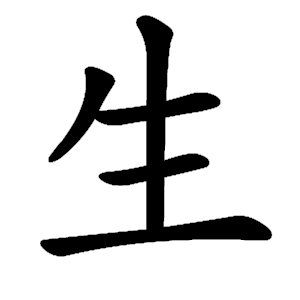生
- to be born, to live;
- raw, uncooked;
It represents the concepts of birth, growth, and existence. Its meanings include "to be born," "to give birth," "to live," and it also means "student."
Etymology
It depicts the image of grass sprouting from the ground. The current form consists of two lines added above the 土 (earth) character, though in oracle bone script these two characters were clearly distinct.
In summary, 生 symbolizes sprouting or growth from the earth, with a rich variety of related meanings and some regional variation in writing.
In Korea, China, and Taiwan, the third stroke is a horizontal middle line and the fourth stroke is a vertical downward stroke; in Japan, these two strokes are reversed. The usual stroke order is ↙ → → ↓ →, while the Japanese stroke order is ↙ → ↓ → →, similar to the cursive style.
Characters with 生
Words that derived from 生
- 고생(苦生)–trouble; hardship
- 고생길(苦生길)–arduous path
- 공생(共生)–cooperation; mutualism; symbiosis
- 대학생(大學生)–college student
- 발생(發生)–occurrence; outbreak
- 사생(死生)–life and death
- 사회생활(社會生活)–social life; work life
- 생(生)–living
- 생기(生氣)–life; liveliness
- 생력요소(生力要素)–vitality element
- 생령(生靈)–divine spirit
- 생령요소(生靈要素)–living spirit element
- 생리(生理)–physiology; living habit; nature; menstruation
- 생명(生命)–life
- 생산(生産)–production
- 생산되다(生産되다)–be produced
- 생성(生成)–creation; formation
- 생소(生素)–life element
- 생심(生心)–spirit mind
- 생육(生育)–giving birth; rearing; birth; growth
- 생존(生存)–survival
- 생채(生菜)–fresh salad
- 생체(生體)–living body
- 생활(生活)–life; living; livelihood; activity
- 생활 양식(生活樣式)–lifestyle
- 생활 환경(生活環境)–living environment
- 소생(蘇生/甦生)–revival; recovery
- 소생기(蘇生期)–formation stage
- 실생활(實生活)–real life
- 영생(永生)–immortality
- 위생병(衛生兵)–medic
- 인생(人生)–life; lifetime
- 인생길(人生길)–path of life; course of life; journey of life
- 재생(再生)–resurrection; recycling; playback; reproduction
- 재생되다(再生되다)–be resurrected; be recycled; be played back; be reproduced
- 중생(衆生)–sentient beings
- 출생(出生)–birth
- 탄생(誕生)–birth; establishment; start; opening
- 파생어(派生語)–derivative
- 竹手一 (HQM)
- ⿻ 𠂉 土
